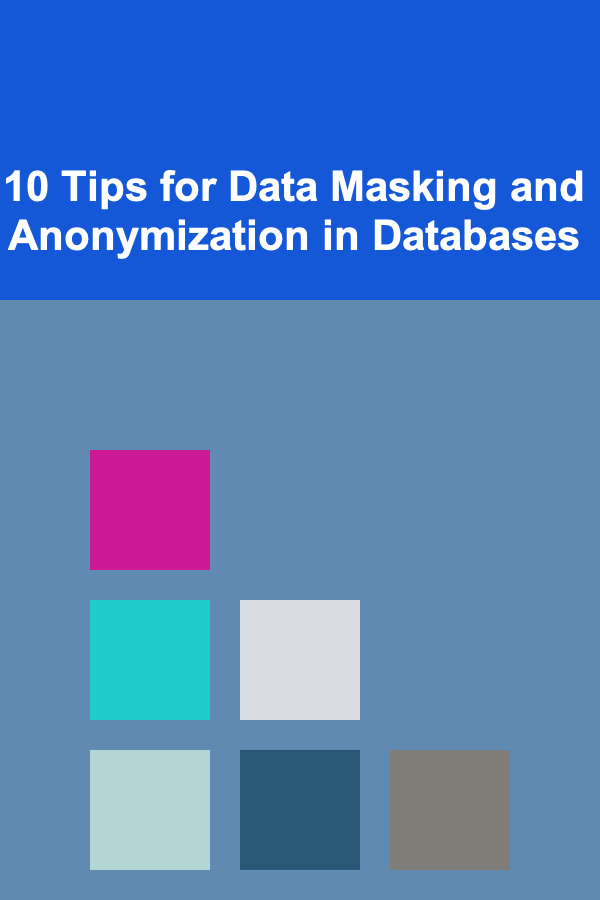
10 Tips for Data Masking and Anonymization in Databases
ebook include PDF & Audio bundle (Micro Guide)
$12.99$10.99
Limited Time Offer! Order within the next:

Data privacy has become an increasingly important concern in today's digital world. With the growing number of cyber threats and stricter regulations such as GDPR and CCPA, organizations are facing pressure to ensure that sensitive data is protected. One effective method of safeguarding this data is through data masking and anonymization. These techniques help protect sensitive information while allowing organizations to continue using data for analytical and operational purposes.
In this article, we will explore 10 essential tips for effective data masking and anonymization in databases. These strategies not only ensure data privacy but also improve the overall security of your database systems.
Understand the Difference Between Data Masking and Data Anonymization
Before diving into the techniques of data masking and anonymization, it's crucial to understand the distinction between the two:
- Data Masking: This involves hiding sensitive data by replacing it with fictional or scrambled data that retains the original format and characteristics. This allows applications to continue functioning while ensuring that real data is not exposed to unauthorized users.
- Data Anonymization: This technique involves irreversibly altering data in such a way that individuals cannot be identified from the data, even if the anonymized data is exposed. Unlike masking, anonymization ensures that the data cannot be used to re-identify a person or entity.
Both methods are essential for protecting sensitive information in databases, and understanding when to use each one is vital to ensuring compliance with data protection regulations.
Identify Sensitive Data for Masking or Anonymization
The first step in implementing data masking and anonymization is identifying which data needs to be protected. Sensitive data can include personally identifiable information (PII) such as names, social security numbers, credit card details, medical records, and any other data that could lead to the identification of an individual or organization.
To properly protect sensitive data, perform a thorough audit of your database to identify all the areas where sensitive information is stored. Once identified, ensure that these data points are masked or anonymized based on the level of sensitivity and the intended use.
Choose the Right Masking or Anonymization Technique
Depending on the requirements of your organization, different masking and anonymization techniques may be more suitable for different types of data. Here are some popular techniques:
- Static Data Masking (SDM): This involves replacing sensitive data in your production database with fictitious data for non-production environments. It's typically used for testing and development purposes.
- Dynamic Data Masking (DDM): This technique allows organizations to mask data in real-time without altering the underlying data stored in the database. It's ideal for situations where users with different access levels need to interact with the database without seeing the full data.
- Data Anonymization Techniques: These include data perturbation (adding random noise), k-anonymity (grouping data points into indistinguishable sets), and differential privacy (introducing uncertainty into data to prevent re-identification). The choice of technique will depend on the specific requirements for anonymization and the level of protection needed.
Implement Role-Based Access Control (RBAC)
One of the most effective ways to limit access to sensitive data is by implementing Role-Based Access Control (RBAC). RBAC restricts access to data based on the roles and responsibilities of users within an organization. By assigning different access levels to different users, you can ensure that sensitive data is only accessible to those who require it for their job functions.
When combined with data masking, RBAC ensures that even authorized users only see the masked or anonymized version of sensitive data when needed. This adds an additional layer of protection by limiting exposure to sensitive information.
Regularly Test Your Masking and Anonymization Processes
To ensure that your data masking and anonymization strategies are working effectively, it is crucial to regularly test your processes. This involves performing audits and checks to verify that data is being properly masked or anonymized and that no sensitive data is exposed during operations.
Testing should also cover various scenarios, including different user roles, data queries, and access requests. Regular testing ensures that vulnerabilities are identified and rectified promptly, and it helps you stay compliant with regulations that mandate data protection.
Ensure Compliance with Privacy Regulations
With stringent data protection regulations like GDPR , CCPA , and HIPAA in place, it's essential to ensure that your data masking and anonymization practices comply with relevant legal frameworks. Non-compliance can result in severe financial penalties and damage to your organization's reputation.
To comply with privacy regulations:
- Document your data protection practices: Keep a record of all masking and anonymization methods used in your organization.
- Review and update practices regularly: Privacy regulations are constantly evolving, so it's important to stay up-to-date with any changes and adjust your processes accordingly.
- Consult with legal experts: Seek advice from privacy experts to ensure that your practices align with the legal requirements for data protection.
Avoid Data Reversal
One of the key risks of data masking is the potential for data reversal, which occurs when masked data can be reverse-engineered to reveal the original sensitive data. To avoid data reversal, use robust masking techniques that ensure the transformed data cannot be used to reconstruct the original information.
Some methods to avoid data reversal include using unpredictable values, such as random numbers or characters, rather than simple substitutions. For example, when masking a phone number, don't just replace digits with the same digit (e.g., replacing 5 with 5), but rather use a completely random set of digits.
Ensure Data Integrity
While masking and anonymizing sensitive data, it's crucial to maintain data integrity. This means ensuring that the underlying structure and relationships between different data elements are preserved, even if the data itself is masked or anonymized.
For example, if you're masking a set of names, ensure that the format and structure of the data remain consistent, so that downstream systems relying on the data can still function correctly. Data integrity is particularly important when dealing with relational databases or systems that perform complex analyses based on relationships between datasets.
Implement Strong Encryption Practices
While data masking and anonymization are effective in protecting sensitive data, encryption adds an additional layer of security. When data is encrypted, it becomes unreadable without the appropriate decryption keys, making it virtually impossible for unauthorized users to access sensitive information.
Encrypting your database ensures that even if an attacker gains access to the raw data, it will be unreadable unless they can decrypt it. Strong encryption protocols like AES-256 (Advanced Encryption Standard) should be implemented to secure data at rest and during transit.
Educate Your Team and Foster a Culture of Security
Data masking and anonymization techniques are only effective if your organization fosters a strong culture of data security. Educate your employees and stakeholders on the importance of protecting sensitive data and provide regular training on best practices for data handling.
Encourage team members to follow security protocols, including the proper use of data masking tools, secure access management, and adherence to legal and ethical standards. Regular workshops and awareness campaigns can help reinforce these principles and reduce the risk of security breaches.
Conclusion
Data masking and anonymization are powerful techniques that help organizations protect sensitive information while complying with privacy regulations. By following the tips outlined in this article, you can ensure that your database security is robust and that sensitive data is properly protected from unauthorized access and potential breaches.
As data privacy concerns continue to grow, adopting and refining your data protection strategies is essential for safeguarding your organization and maintaining the trust of your customers. With the right tools, processes, and mindset, you can build a secure and compliant data environment that meets the needs of both your organization and its stakeholders.
Reading More From Our Other Websites
- [Home Pet Care 101] How to Make Homemade Pet Treats for Your Furry Friend
- [Stamp Making Tip 101] How to Create Durable Foam Stamps for Kids' Art Projects
- [Personal Finance Management 101] How to Protect Your Finances from Inflation and Economic Uncertainty
- [Home Staging 101] How to Stage a Small Apartment for Maximum Appeal
- [Home Staging 101] How to Stage Your Home for Seasonal Buyers
- [Star Gazing Tip 101] How to Use a Red Light Flashlight to Preserve Night Vision While Star‑Gazing
- [Screen Printing Tip 101] Best Custom Screen Printing Solutions for Luxury Apparel Brands
- [Personal Investment 101] 5 Ways to Build Passive Income with Deep Learning
- [Simple Life Tip 101] The Best Simple‑Life Cleaning Schedule for Busy Couples
- [Organization Tip 101] How to Use Password Managers to Keep Your Accounts Secure

How to Create a Realistic Monthly Budget
Read More
How To Create Engaging Polls and Quizzes
Read More
How to Make a DIY All-Purpose Cleaner
Read More
How to Start Your Daily Meditation Practice
Read More
How to Open a Small Restaurant or Café: A Comprehensive Guide
Read More
10 Tips for Financial Advisors Serving High-Net-Worth Individuals
Read MoreOther Products

How to Create a Realistic Monthly Budget
Read More
How To Create Engaging Polls and Quizzes
Read More
How to Make a DIY All-Purpose Cleaner
Read More
How to Start Your Daily Meditation Practice
Read More
How to Open a Small Restaurant or Café: A Comprehensive Guide
Read More